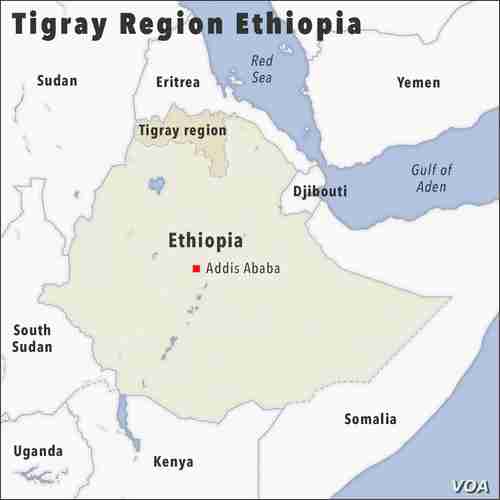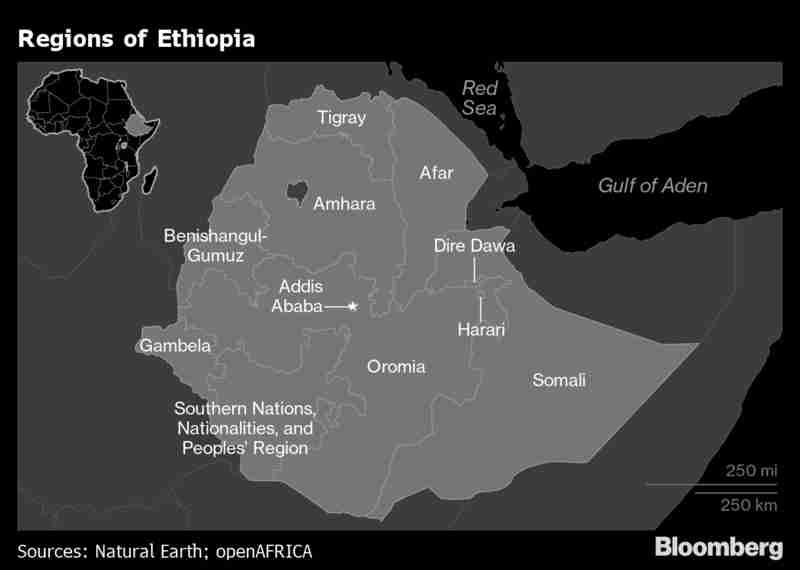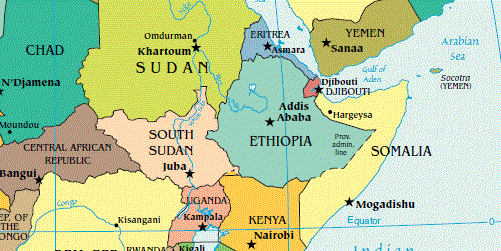
Dynamics

|
Generational Dynamics |
| Modern Generational Theory | |
| HOME WEB LOG COUNTRY STUDIES COMMENT FORUM | |
| DOWNLOADS FOURTH TURNING ARCHIVE ABOUT | |
Generational history of Ethiopia and Eritrea
by
John J. Xenakis
This morning's key headlines from GenerationalDynamics.com
 |
The ethnic civil war in Ethiopia escalated sharply on Saturday when the army of the Tigray ethnic group fired missiles at the airport in Asmara, the capital city of the Eritrea, bringing Eritrea into Ethiopia's civil war.
The Tigray ethnic group occupies the Tigray region in northern Ethiopia, with Eritrea on its northern border, and Sudan on its western border. Ethiopia's federal government, headed by prime minister Abiy Ahmediat of the Oromo ethnic tribe, is located in the capital city Addis Ababa in central Ethiopia. For the last few weeks, government forces have been attacking Tigray with missiles and militias. The militias are mostly ethnic Amharas, who are historic enemies of the Tigrays. The Amhara region is directly south of the Tigray region.
Over 20,000 refugees from Tigray have abandoned their homes and belongings and have fled into Sudan to refugee camps along the border to escape the violence. Sudanese officials have said that as the fighting escalates, they expect to see 200,000 refugees.
At the same time, terrorist groups from ISIS and al-Shabaab have been entering Ethiopia from Somalia and, according to Ethiopian officials, plotted to attack various parts of the country, seizing the window of opportunity opened by the conflict in the Tigray region.
Ethiopia is a hotbed of tensions between different ethnic groups. There are already growing clashes between other ethnic groups in other parts of Ethiopia, and there are fears that waves of refugees will cross into Kenya and Somalia, possibly destabilizing the entire region.
The Tigray attack on the airport in Asmara, Eritrea, was something of a surprise, and puzzled analysts since it seems to have no purpose except to provoke a retaliatory attack by Eritrea on Tigray.
However, Debretsion Gebremichael, the leader of the Tigray People’s Liberation Front (TPLF), says that the airport was a "legitimate target," since it was being used by Ethiopian forces. "As long as troops are here fighting, we will take any legitimate military target and we will fire. We will fight them on all fronts with whatever means we have," he said
Ethiopia’s prime minister, Abiy Ahmediat, launched military operations in Tigray two weeks ago after he accused local authorities of attacking a military camp in the region and attempting to loot military assets. The TPLF denies the charge and has accused the prime minister of concocting the story to justify deploying the offensive.
On Sunday, the Abiy government rejected any calls for a ceasefire:
"With unwavering commitment we will see this project through to the end ... As a sovereign nation, Ethiopia reaffirms its capability and resolve to manage ... its own rule of law operation without any external intervention. ...The Federal Government of Ethiopia is asserting its constitutional mandate to uphold the rule of law according to the laws of the land."
With Abiy unwilling to consider a ceasefire, with the Tigrays attacking Eritrea, and with tens of thousands of refugees pouring into neighboring countries, observers are concerned that this could escalate into a full-scale war in the Horn of Africa.
 |
Ethiopia's last generational crisis war (1975-1991) was a protracted war between the Tigray People’s Liberation Front (TPLF) against the vicious Marxist Derg military government in Addis Ababa, which climaxed in 1991 when they were finally toppled by the TPLF. The Tigrays are only 6% of Ethiopia's population but they dominated Ethiopia's government for decades, following the 1991 victory.
The Oromo ethnic group, of which Abiy is a member, and the Amhara ethnic group are the two largest ethnic groups in Ethiopia. During the generational Awakening era, mass protests by these two groups targeted the Tigray coalition government, resulting in a "velvet coup" that brought Abiy to power as prime minister in 2018. At the same time Ethiopia and Eritria signed a peace deal ending a bitter border dispute between the two countries.
Shortly after that, Abiy won the Nobel Peace Prize, which is always laughable these days. The TPLF says that, since then, Abiy's government has systematically persecuted Tigrays since he took office. After Abiy became prime minister in April 2018, several high-ranking TPLF officials were prosecuted for human rights abuses and corruption. The TPLF responded by accusing Abiy of targeting them in a politically motivated campaign.
When Abiy’s government delayed this year’s general elections until 2021, citing Covid-19, the TPLF accused the prime minister of using the pandemic to hold on to power beyond his mandate. The TPLF then unilaterally held regional elections in September. The federal government refused to accept the results, and this led to the federal government's military attack on Tigray.
Abiy apparently expects a quick victory against the Tigrays, but analysts point out that the TPLF remains a fighting force of up to 250,000 battle-hardened troops. Furthermore large elements of the Northern Command leadership of the national Ethiopian army are Tigrays, meaning that Abiy cannot expect full loyalty from the army.
 |
These two countries, Ethiopia and Eritrea, have been linked since at least the second century AD.
Ethiopia adopted Christianity in the 4th century, and was a tribal society ruled by emperors until the 1800s. However, a split between Ethiopia and Eritrea occurred in the 700s with the rise of Islam and the Arab trade along the Red Sea, and what is now Eritrea became part of the Islamic Empire, and later the Ottoman Empire.
Italy colonized the region in the 1860s, in the so-called Scramble for Africa, so named because after it was discovered in the 1850s that malaria could be controlled with quinine, England, Belgium, France, Portugal, Italy, Spain and Germany all competed with each other to colonize different parts of Africa.
In 1869, the Suez Canal opened, connecting the Red Sea with the Mediterranean Sea, and Italian shipping firms became active. Large stretches of Eritrea's coastline were acquired from the local sultans and transferred to Italian control. By the mid-1880s, the Italian army moved into Eritrea, displacing the Ottomans, and challenging the Ethiopian empire.
In 1889, Menelik II rose to the position of Emperor of Ethiopia. The "Italian-Ethiopian War" (1889-1896) was a generational crisis war for Ethiopia. Menelik inflicted on Italy the most humiliating and bloody defeat ever experienced by a colonial power in Africa. In the outcome, Italy retained Eritrea as a Red Sea colony, populating it with thousands of Italian settlers, developing road and rail transport, but doing little to improve the lives of Eritreans.
Ethiopia gained independence, and by 1914 and the beginning of WW I, all of black Africa except Ethiopia and Liberia were European colonies.
By 1935, Eritrea was a colony of Italy, and Ethiopia had a new emperor, one who had taken the title Haile Selassie, meaning "Might of the Trinity," emphasizing the fact that Ethiopia was a largely Christian country.
In October 1935, Italian dictator Benito Mussolini ordered an invasion of Ethiopia, partly in revenge for Italy's humiliating defeat in 1896. Mussolini announced the establishment of a new Italian empire, including Ethiopia, Eritrea and Somalia, under the name Italian East Africa. Haile Selassie fled the country.
When Mussolini brought Italy into World War II on Hitler's side, in June 1940, Haile Selassie won the cooperation of Britain in launching a counterattack against the Italian forces in Italian East Africa. By 1941, Haile Selassie was once again emperor of Ethiopia. After the war, the United Nations made Eritrea a part of Ethiopia, an autonomous federal province with its own constitution and elected government, something that the Muslims in Eritrea strongly opposed.
From the above description, one can see that although World War II was a generational crisis war for Italy and Britain, with part of the war fought on Ethiopian soil, it was not a crisis war for Ethiopia itself. In fact, with the previous crisis war having climaxed in 1896, this was a generational Unraveling era for Ethiopia. In such an era (like America in the 1990s), there is little appetite for war among the general population, except perhaps for quick police actions. Although Ethiopia and Eritrea changed hands several times during the WW II time period, the fighting was mostly between foreign armies, and did not heavily involve the local population.
In the mid-1950s, the region entered a generational Crisis era, and the fault line between Muslims and Christians began to inflame. In 1958, Eritrea's Muslim leaders formed the Eritrean Liberation Front (ELF), consisting mainly of students, intellectuals, and urban wage laborers. Low-level warfare continued throughout the 1960s.
In the 1970s, the Eritrean independence movement took another turn with the formation of a powerful Marxist offshoot of the ELF, the Eritrean People's Liberation Front (EPLF). Haile Selassie was toppled in 1974, after which factional warfare began to increase.
This might have led to a full-scale generational crisis war, but there was a major development: In 1977, the USSR allied with the Ethiopian government, took control of Eritrea's Red Sea ports, and provided Ethiopia's government with huge supplies of arms, enough to suppress the EPLF guerrillas.
The guerrilla war fought by Marxist rebels against the well-armed Ethiopian government climaxed in May 1991 with the collapse of Ethiopia's government, coincident with the collapse of the USSR. Eritrea finally declared independence. By that time, there were 500,000 refugees that had fled to refugee camps in Sudan, and they had to be resettled in Ethiopia and Eritrea.
In 1998, a new border war broke out between Eritrea and Ethiopia. This was a non-crisis war, with a quality very similar to World War I, where trenches were dug, mines were laid, and bodies of dead soldiers were strewn about. Of the 400,000 men who fought on both sides, 50,000 soldiers died.
A peace deal in 2000 ended the two-year border war, but it was never fully implemented, and a new peace deal was signed in 2018.
Sources:
Related Articles:
(Comments: For reader comments, questions and discussion,
see the Generational Dynamics World View News thread of the Generational
Dynamics forum. Comments may be posted anonymously.)
(16-Nov-2020)
Permanent Link
Receive daily World View columns by e-mail
Donate to Generational Dynamics via PayPal
Web Log Summary - 2020
Web Log Summary - 2019
Web Log Summary - 2018
Web Log Summary - 2017
Web Log Summary - 2016
Web Log Summary - 2015
Web Log Summary - 2014
Web Log Summary - 2013
Web Log Summary - 2012
Web Log Summary - 2011
Web Log Summary - 2010
Web Log Summary - 2009
Web Log Summary - 2008
Web Log Summary - 2007
Web Log Summary - 2006
Web Log Summary - 2005
Web Log Summary - 2004
Web Log - December, 2020
Web Log - November, 2020
Web Log - October, 2020
Web Log - September, 2020
Web Log - August, 2020
Web Log - July, 2020
Web Log - June, 2020
Web Log - May, 2020
Web Log - April, 2020
Web Log - March, 2020
Web Log - February, 2020
Web Log - January, 2020
Web Log - December, 2019
Web Log - November, 2019
Web Log - October, 2019
Web Log - September, 2019
Web Log - August, 2019
Web Log - July, 2019
Web Log - June, 2019
Web Log - May, 2019
Web Log - April, 2019
Web Log - March, 2019
Web Log - February, 2019
Web Log - January, 2019
Web Log - December, 2018
Web Log - November, 2018
Web Log - October, 2018
Web Log - September, 2018
Web Log - August, 2018
Web Log - July, 2018
Web Log - June, 2018
Web Log - May, 2018
Web Log - April, 2018
Web Log - March, 2018
Web Log - February, 2018
Web Log - January, 2018
Web Log - December, 2017
Web Log - November, 2017
Web Log - October, 2017
Web Log - September, 2017
Web Log - August, 2017
Web Log - July, 2017
Web Log - June, 2017
Web Log - May, 2017
Web Log - April, 2017
Web Log - March, 2017
Web Log - February, 2017
Web Log - January, 2017
Web Log - December, 2016
Web Log - November, 2016
Web Log - October, 2016
Web Log - September, 2016
Web Log - August, 2016
Web Log - July, 2016
Web Log - June, 2016
Web Log - May, 2016
Web Log - April, 2016
Web Log - March, 2016
Web Log - February, 2016
Web Log - January, 2016
Web Log - December, 2015
Web Log - November, 2015
Web Log - October, 2015
Web Log - September, 2015
Web Log - August, 2015
Web Log - July, 2015
Web Log - June, 2015
Web Log - May, 2015
Web Log - April, 2015
Web Log - March, 2015
Web Log - February, 2015
Web Log - January, 2015
Web Log - December, 2014
Web Log - November, 2014
Web Log - October, 2014
Web Log - September, 2014
Web Log - August, 2014
Web Log - July, 2014
Web Log - June, 2014
Web Log - May, 2014
Web Log - April, 2014
Web Log - March, 2014
Web Log - February, 2014
Web Log - January, 2014
Web Log - December, 2013
Web Log - November, 2013
Web Log - October, 2013
Web Log - September, 2013
Web Log - August, 2013
Web Log - July, 2013
Web Log - June, 2013
Web Log - May, 2013
Web Log - April, 2013
Web Log - March, 2013
Web Log - February, 2013
Web Log - January, 2013
Web Log - December, 2012
Web Log - November, 2012
Web Log - October, 2012
Web Log - September, 2012
Web Log - August, 2012
Web Log - July, 2012
Web Log - June, 2012
Web Log - May, 2012
Web Log - April, 2012
Web Log - March, 2012
Web Log - February, 2012
Web Log - January, 2012
Web Log - December, 2011
Web Log - November, 2011
Web Log - October, 2011
Web Log - September, 2011
Web Log - August, 2011
Web Log - July, 2011
Web Log - June, 2011
Web Log - May, 2011
Web Log - April, 2011
Web Log - March, 2011
Web Log - February, 2011
Web Log - January, 2011
Web Log - December, 2010
Web Log - November, 2010
Web Log - October, 2010
Web Log - September, 2010
Web Log - August, 2010
Web Log - July, 2010
Web Log - June, 2010
Web Log - May, 2010
Web Log - April, 2010
Web Log - March, 2010
Web Log - February, 2010
Web Log - January, 2010
Web Log - December, 2009
Web Log - November, 2009
Web Log - October, 2009
Web Log - September, 2009
Web Log - August, 2009
Web Log - July, 2009
Web Log - June, 2009
Web Log - May, 2009
Web Log - April, 2009
Web Log - March, 2009
Web Log - February, 2009
Web Log - January, 2009
Web Log - December, 2008
Web Log - November, 2008
Web Log - October, 2008
Web Log - September, 2008
Web Log - August, 2008
Web Log - July, 2008
Web Log - June, 2008
Web Log - May, 2008
Web Log - April, 2008
Web Log - March, 2008
Web Log - February, 2008
Web Log - January, 2008
Web Log - December, 2007
Web Log - November, 2007
Web Log - October, 2007
Web Log - September, 2007
Web Log - August, 2007
Web Log - July, 2007
Web Log - June, 2007
Web Log - May, 2007
Web Log - April, 2007
Web Log - March, 2007
Web Log - February, 2007
Web Log - January, 2007
Web Log - December, 2006
Web Log - November, 2006
Web Log - October, 2006
Web Log - September, 2006
Web Log - August, 2006
Web Log - July, 2006
Web Log - June, 2006
Web Log - May, 2006
Web Log - April, 2006
Web Log - March, 2006
Web Log - February, 2006
Web Log - January, 2006
Web Log - December, 2005
Web Log - November, 2005
Web Log - October, 2005
Web Log - September, 2005
Web Log - August, 2005
Web Log - July, 2005
Web Log - June, 2005
Web Log - May, 2005
Web Log - April, 2005
Web Log - March, 2005
Web Log - February, 2005
Web Log - January, 2005
Web Log - December, 2004
Web Log - November, 2004
Web Log - October, 2004
Web Log - September, 2004
Web Log - August, 2004
Web Log - July, 2004
Web Log - June, 2004